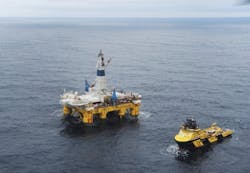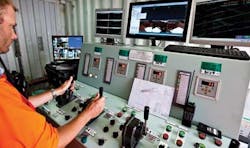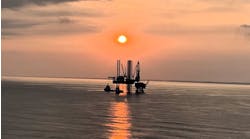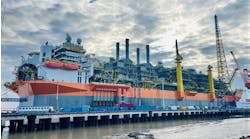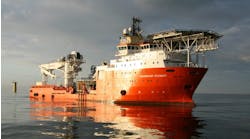Renee L. Pellemans
Dockwise
Recognizing the huge potential for both onshore and offshore business in Russia, Dockwise established a regional office in Moscow in 2009. One project that has already been completed involved transporting two decommissioned nuclear-powered submarines as deck cargo from their base in Kamchatka to the shipyard in Bolshoi Kamen for full dismantlement. The loading, transport, and discharge of two nuclear powered submarines onboard one vessel had never been attempted before.
The company was also selected to perform the transport and float-over installations for the current Vyborg project in South Korea. The program is big in scope and size, and involves moving two 15,000-metric ton (16,535-ton) semisubmersible hulls and two 19,000-metric ton (20,944-ton) topsides from northern Russia to South Korea, a voyage of more than 27,000 km (16,777 mi).
The consignments comprise two giant drilling platforms that had been commissioned for the Shtokman gas field development in the Russian sector of the Barents Sea. The original location of the float-overs was to be in Murmansk, in subarctic conditions. However, following last year’s postponement of Shtokman for a further two to three years, the float-overs were switched to South Korea, close to the Samsung yard, allowing the rigs to be re-deployed nearby around Sakhalin Island.
The change of venue to Korea meant that there was a very short amount of time (three months to be exact) to complete work that had previously taken 17 months to accomplish. Therefore, a different approach was needed, and flexibility was at a premium. The equipment that had originally been scheduled for Murmansk – including tugs, a complete mooring spread, and anchoring equipment – now needed to be available 27,000 km away in South Korea.
Transport arrangements
Following 20 months of engineering, procurement, and preparations, the company entered the operational phase of this project on May 6, 2010, when the first of the two hulls was loaded onto the Dockwise vesselTalisman near the Vyborg shipyard in northwest Russia.
The company’sBlack Marlin vessel was then used to transport the first of the two topsides to the float-over location in South Korea, where it would be mated with the first hull brought over from Vyborg.
At one point during the final stage of the first float-over execution in July, around 60 company personnel and contractors were working together on site in South Korea. This work included final outfitting of the first hull, and the final preparation of theBlack Marlin and topside through installation of measurement equipment.
It was also Dockwise’s scope to design and install the pre-laid 12-anchor spread, hook the hull to this spread, and ballast the hull to its mating draft. This phase of the project involved the use of five tugs, two anchor handlers, one workboat, two anchor barges, one test barge, a crane barge, three launch boats, and standby vessels.
Floating float-over
One especially innovative feature of this project was the “floating float-over,” completed without a fixed structure. Instead, a floating semisubmersible hull was anchored and ballasted down before the float-over operation was performed.
On June 28, 2010, a topside weighing close to 19,000 metric tons (20,944 tons) was successfully loaded onto theBlack Marlin. Next, the hull was towed to the float-over location in South Korea using four heavy tugs, and hooked to its anchor spread. On July 4, the Black Marlin arrived at the float-over location. After the vessel docked into the hull, the hull was ballasted down to 27 m (88 ft) draft. Ballasting operations were under way in order to lock the leg mating units and align the hull columns and the topside.
(Above) Float-over of the first hull on the transportation bargeTalisman.(Below) Project Superintendent Erik van Empel controls the four mating winches for the wires which guide the entry of the Black Marlin in between the columns of the anchored Vyborg SSFDR Hull.
This was a 24-hour-a-day operation, and everyone worked together – including the client and third parties, such as Samsung, MWS, and sub-contractors, supported by theBlack Marlin crew. The next steps included welding the columns to the topside, after which they released the load from the leg mating units and began ballast operations to transfer the full load of the topside onto the hull columns. On July 10, the Black Marlin was retracted from the completed rig and de-ballasting operations were completed.
Transport of the second hull began in late August. The hull is scheduled to arrive in South Korea later this fall. Upon arrival, the hull will be immediately prepared for hook up to the anchor spread, which was left in place during the first operation.
During this same period, the second topside will be skidded onboard theBlack Marlin, which has undergone minor modifications as a result of the lessons learned during the first operation. The goal is to start the floatover at the end of October. After completion, the Black Marlin will go to a reinstatement yard to bring the vessel to its original configuration for her next contract. In the meantime, the anchor spread will be removed and all equipment will be returned to its original location.
Offshore Articles Archives
View Oil and Gas Articles on PennEnergy.com


